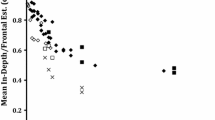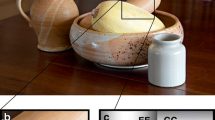Abstract
It is proposed that any cue for the visual discrimination of shape, in particular the discrimination of curved contours, should be such that the perceptual relationships defined by the cue are invariant under changes in observer viewpoint. Such relationships may be quantified by the Weber fraction; that is, the ratio Δc/c, where, for any particular value c of the cue, Δc is the smallest difference in c that can be detected. Eight geometric attributes of curved contours having one symmetry axis and parallel chords (a standard stimulus configuration) were examined for invariance of the Weber fraction under symmetry-preserving affine transformations of the image plane (changes in viewpoint are well approximated by affine transformations when depth is small relative to viewing distance). The attributes, each investigated in previous psychophysical studies, were equivalent-curvature, radius-of-curvature, turning-angle, arc-length-divided-by-chord-length, arc-length, maximum-deviation (sag), area, and mean-deviation. Three of the attributes, namely sag, area, and mean-deviation, satisfied the viewpoint-invariance condition; the remainder failed. These results are considered in relation to previously published empirical data on the Weber fraction for contour-curvature discrimination.
Similar content being viewed by others
References
Andrews DP, Butcher AK, Buckley BR (1973) Acuities for spatial arrangement in line figures: human and ideal observers compared. Vision Res 13:599–620
Attneave F (1954) Some informational aspects of visual perception. Psychol Rev 61:183–193
Cermak GW (1977) Performance in a delayed comparison discrimination task as a function of stimulus interpretation. Percept Psychophys 21:69–76
Costa T, Ferraro M (1993) A neural model of discrete and continuous modes of visual discrimination. Spatial Vision 7:243–255
Della Valle L, Andrews TG, Ross S (1956) Perceptual thresholds of curvilinearity and angularity as functions of line length. J. Exp Psychol 51:343–347
Fahle M (1986) Curvature detection in the visual field and a possible physiological correlate. Exp Brain Res 63:113–124
Fahle M (1991) Parallel perception of vernier offsets, curvature, and chevrons in humans. Vision Res 31:2149–2184
Falmagne J-C (1985) Elements of psychophysical theory. Clarendon Press, Oxford
Farrell JE, Shepard RN (1981) Shape, orientation, and apparent rotational motion. J Exp Psychol [Hum Percept] 7:477–486
Ferraro M, Foster DH (1986) Discrete and continuous modes of curved-line discrimination controlled by effective stimulus duration. Spatial Vision 1:219–230
Fisher RA (1922) On the mathematical foundations of theoretical statistics. Philos Trans R Soc London Ser A 222:309–368
Foster DH (1975) Visual apparent motion and some preferred paths in the rotation group SO(3). Biol Cybern 18:81–89
Foster DH (1978) Visual apparent motion and the calculus of variations. In: Leeuwenberg ELJ, Buffart HFJM (eds) Formal theories of visual perception. Wiley, Chichester, pp 67–82
Foster DH (1980) A spatial perturbation technique for the investigation of discrete internal representations of visual patterns. Biol Cybern 38:159–169
Foster DH (1983) Visual discrimination, categorical identification, and categorical rating in brief displays of curved lines: implications for discrete encoding processes. J Exp Psychol [Hum Percept] 9:785–806
Foster DH, Cook MJ (1989) Categorical and noncategorical discrimination of curved lines depends on stimulus duration, not performance level. Perception 18:519
Foster DH, Simmons DR, Cook MJ (1993) The cue for contour-curvature discrimination. Vision Res 33:329–341
Guggenheimer HW (1977) Differential geometry. Dover, New York (original publication McGraw-Hill, New York, 1963)
Hopcroft JE, Huttenlocher DP, Wayner PC (1992) Affine invariants for model-based recognition. In: Mundy JL, Zisserman A (eds) Geometric invariance in computer vision. MIT Press, Cambridge, Mass, pp 354–374
Koenderink JJ, Doorn AJ van (1982) The shape of smooth objects and the way contours end. Perception 11:129–137
Koenderink JJ, Richards W (1988) Two-dimensional curvature operators. J Opt Soc Am [A] 5:1136–1141
Kramer D, Fahle M (1993) On curvature detection in lines and edges. Invest Ophthalmol Vis Sci 34:778
Lamdan Y, Schwartz JT, Wolfson HJ (1988) Object recognition by affine invariant matching. In: Proceedings of Computer Society Conference on Computer Vision and Pattern Recognition, Ann Arbor, MI, IEEE, pp 335–344
Laming D (1986) Sensory analysis. Academic Press, London
Lehky SR, Sejnowski TJ (1988) Network model of shape-from-shading: neural function arises from both receptive and projective fields. Nature 333:452–454
Leshowitz B, Taub HB, Raab DH (1968) Visual detection of signals in the presence of continuous and pulsed backgrounds. Percept Psychophys 4:207–213
Link NK, Zucker SW (1988) Corner detection in curvilinear dot grouping. Biol Cybern 59:247–256
Moons T, Pauwels EJ, Van Gool LJ, Oosterlinck A (1993) Foundations of semi-differential invariance and its application to recognition under affine distortion. Int J Comput Vision (in press)
Mundy JL, Zisserman A (eds) (1992) Geometric invariance in computer vision. MIT Press, Cambridge, Mass
Ogilvie J, Daicar E (1967) The perception of curvature. Can J Psychol 21:521–525
Pauwels EJ, Moons T, Van Gool LJ, Kempenaers P, Oosterlinck A (1993) Recognition of planar shapes under affine distortion. Int J Comput Vision (in press)
Phillips T-Y, Rosenfeld A (1987) A method of curve partitioning using arc-chord distance. Pattern Recognition Lett 5:285–288
Ramer U (1972) An iterative procedure for the polygonal approximation of plane curves. Comput Graphics Image Processing 1:244–256
Richards W, Dawson B, Whittington D (1986) Encoding contour shape by curvature extrema. J Opt Soc Am [A] 3:1483–1491
Simmons DR, Foster DH (1992) Segmenting textures of curved-line elements. In: Orban GA, Nagel H-H (eds) Artificial and biological vision systems. Springer, Berlin Heidelberg New York, pp 324–349
Stuart A, Ord JK (1991) Kendall's advanced theory of statistics. (Classical inference and relationship, vol 2, 5th edn). Edward Arnold, London
Thompson DW, Mundy JL (1987) 3-Dimensional model-matching from an unconstrained viewpoint. In: Proc IEEE Int Conf on Robotics and Automation, Raleigh, NC, IEEE, pp 208–220
Wagemans J (1992) Perceptual use of nonaccidental properties. Can J Psychol 46:236–279
Wagemans J (1993) Skewed symmetry: a nonaccidental property used to perceive visual forms. J Exp Psychol [Hum Percept] 19:364–380
Watt RJ (1984) Further evidence concerning the analysis of curvature in human foveal vision. Vision Res 24:251–253
Watt RJ, Andrews DP (1982) Contour curvature analysis: hyperacuities in the discrimination of detailed shape. Vision Res 22:449–460
Weber EH (1834) De Tactu. Koehler, Leipzig
Weiss I (1992) Noise resistant invariants of curves. In: Mundy JL, Zisserman A (eds) Geometric invariance in computer vision. MIT Press, Cambridge, Mass, pp 135–156
Wilson HR (1985) Discrimination of contour curvature: data and theory. J Opt Soc Am [A] 2:1191–1198
Wilson HR, Richards WA (1989) Mechanisms of contour curvature discrimination. J Opt Soc Am [A] 6:106–115
Winer BJ (1971) Statistical principles in experimental design, 2nd edn. McGraw-Hill, New York
Author information
Authors and Affiliations
Rights and permissions
About this article
Cite this article
Foster, D.H., Wagemans, J. Viewpoint-invariant Weber fractions and standard contour-curvature discrimination. Biol. Cybern. 70, 29–36 (1993). https://doi.org/10.1007/BF00202563
Received:
Accepted:
Issue Date:
DOI: https://doi.org/10.1007/BF00202563




